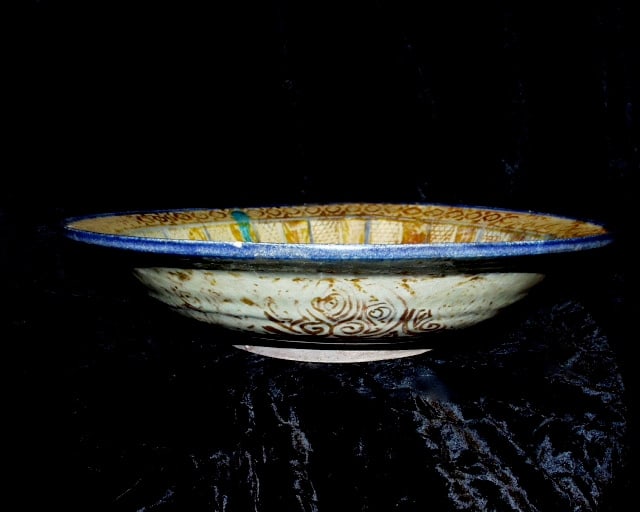Kashan lustre shallow bowl, 1200 CE - 1300 CE
Fritware
14.1 x 3.1
GD.004
Fritware, also known as stone-paste, is a type of fine, hard light-coloured pottery in which frit (ground glass) is added to the clay in order to reduce its fusion temperature,...
Fritware, also known as stone-paste, is a type of fine, hard light-coloured pottery in which frit (ground glass) is added to the clay in order to reduce its fusion temperature, as the resulting mixture can be fired at a much lower temperature than clay alone. The formula may also include quartz or other siliceous material, with an organic compound such as gum or glue added for binding whereas at the final stage a glaze is applied on the surface for the sake of hardening the object. Fritware was invented to produce vessels with a strong white body, which, combined with the tin- glazing on the surface, allowed them to approximate the result of Chinese porcelain. True porcelain was not manufactured in the Islamic world until several centuries later whereas in the meantime the finest Islamic pottery was made of fritware. Chinese ceramics could be considered as the single most important stimulus to the development of fine pottery in the Islamic world. Previously Islamic potters had produced mainly simple kitchen and storage wares, unglazed or with low-fired turquoise glazes. The first meeting with fine Chinese wares taught them that pottery making need not be restricted to serving mere utilitarian ends but could be developed into a skilled artistic enterprise, producing goods of incredible quality and of superlative aesthetic standards for the luxury market. The manufacture of fritware began in Iraq in the 9th century. Between the 10th and the 12th centuries the main centre of manufacture moved to Egypt, from where the technique then spread throughout the Middle-East. In the 13th century the town of Kashan in the Isfahan region in today- Iran was an important centre for the production of fritware. A wide variety of forms are included to the ceramic production attributed to Kashan, from vessels of closed forms such as bottles through plates and bowls to tilework of various dimensions. The town was well situated for the development of this industry, being located near sources of some of the materials necessary for manufacturing the fritware. The high quality wares produced in the late 12th to 14th centuries in Iran, particularly those decorated with luster, are notable for the loquacity of their inscriptions



